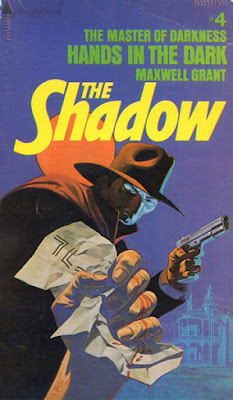TIM SAYS:
There are two distinct versions of the Shadow--the one who appeared in the original pulp magazines beginning in 1931 and the protagonist from the radio show that premiered in 1937. The latter was supposedly based on the pulp character, but was different enough to be essentially a new character.
Both characters are awesome in their own ways and I was introduced to both of them about the same time in my teens. I ended up owning an LP that contained two episodes of the radio show (which I saw at a record store and whined about until my Mom bought it) and a paperback reprint of one of the pulp stories, which I bought off the book rack at Winn Dixie, probably with paper route money.
Over the years, I've read scores of the Shadow stories, but that paperback--reprinting the 1932 story "Hands in the Dark"--will always be one of my favorites simply because it was my first. It begins with a bang--a kidnapping followed by a murder. This is all part of a plot to obtain an obscure clue that will lead to a fortune in stolen loot.
(That clue, by the way, is featured on the magazine cover above. I don't remember figuring it out the first time I read the book and I've always wondered if I would get it if I were to read the novel for the first time as an adult.)
Soon, the Shadow is on the trail of the gang of villains who are responsible for all this intrigue and violence. The plot moves switfly and logically, with spurts of violent action seeded throughout the story. Towards the end, there's a wonderful confrontation between the Shadow and the surviving crooks in a dark attic, followed by a gunfight when a remaining killer is trapped in a railroad car as he shoots it out with the cops.
"Hands in the Dark" is a great example of the best of pulp fiction--a strong story with a clever plot and exciting action.
And, of course, it stars the Shadow, who is 100% pure awesomeness, with an awesome outer coating and an awesome filling in the middle and with awesome sprinkles on the top.
It proves that chapters of background information is not necessary to create a three dimensional character that readers care about. Series' written by different authors under house names can be hit or miss, but generally, they lasted because most of the writers turned out well developed stories that fit into the universe. I often tease Tim that; while his Goodreads list may have 200+ books for a year, 90% or more are under 200 pages. But there is some truth to his argument that a well crafted, tightly written story doesn't need to be any longer. Many of today's authors turn out books of 300-400 pages, but the stories often aren't as well constructed and developed.
I had some criticisms of this book, though. The conversation when Moose Shargin was warning Wing Toy of the abilities of the Shadow and dangers of facing off against him was rife with cliches. I don't know if gangsters in the early 30s really talked like that, but it felt contrived to me. Also, Toy says the gas for the trap would kill, but later he said it just knocked out the victim; the killing came later. Lastly, three different minor characters pulled guns on the gangsters and all three failed to make use of their advantage. Granted, they were all elderly, and at least one was nearly blind, but I felt like yelling “Either pull the trigger or don't pull out the gun”. At least two of them would likely have survived if they had done so.
Finally, I'm torn about the Shadow himself. In this book, at least, he almost feels like a minor character. Granted, he is orchestrating a lot behind the scenes and is often listening in the shadows (pardon the pun). But I'm not sure if it's just a judicious use of an almost mystical character or the uncertainty of how to best use and develop him. Perhaps I should read further stories to see how he is used across several novels. (Shh, don't tell Tim; I can't set the precedent that he's right about such things).
SPECIAL BONUS: A video Tim made on how the character of the Shadow was created:




No comments:
Post a Comment